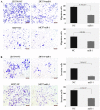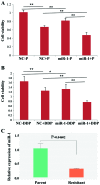Upregulation of microRNA‑1 inhibits proliferation and metastasis of breast cancer
- PMID: 32377691
- PMCID: PMC7248535
- DOI: 10.3892/mmr.2020.11111
Upregulation of microRNA‑1 inhibits proliferation and metastasis of breast cancer
Abstract
Recent studies have shown that microRNAs (miRs) play a key role in the regulation of cancer development. In the present study, reverse transcription‑quantitative PCR was used to detect the expression of miR‑1 in breast cancer and adjacent tissues, and survival analysis was performed to compare the low‑expression groups with the Kaplan-Meier method. Overexpression of miR‑1 was used to observe the effects on the proliferation, migration and invasion of breast cancer cells in vitro and in vivo. Moreover, Bcl‑2 expression was measured by western blotting and luciferase assays after the overexpression of miR‑1. The present study reported that miR‑1 is expressed at low levels in breast cancer and that cell proliferation, migration and invasion are inhibited in miR‑1‑overexpressing cells. Enhanced miR‑1 expression can also increase cell apoptosis. The present study also demonstrated that Bcl‑2 is a potential target of miR‑1. In vivo studies indicate that overexpression of miR‑1 decreases tumor volume and weight in nude mice. The data from the present study demonstrated for the first time that overexpression of miR‑1 increases the sensitivity of breast cancer cells to paclitaxel and cisplatin. The present study provided new evidence for the important role of miR‑1 in the tumorigenesis and drug sensitivity of breast cancer.
Keywords: breast cancer; microrna-1; Bcl-2; proliferation; metastasis.
Figures







References
MeSH terms
Substances
LinkOut - more resources
Full Text Sources
Medical

